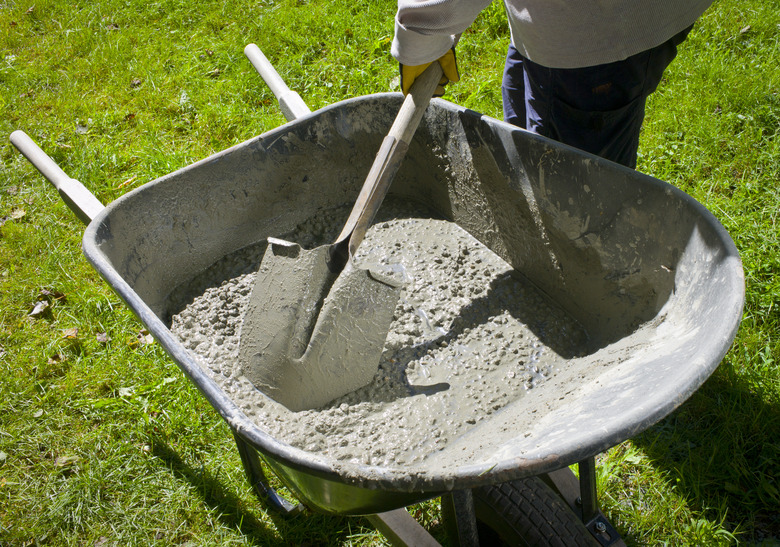How Much Water To Use For A 60-Pound Bag Of Concrete Mix?
We may receive a commission on purchases made from links.
As a rule of thumb, you need about a pint of water for every 15 pounds of concrete mix, so for a 60-pound bag, you need 4 pints. This should produce a pasty consistency that will hold its shape if you mold it. Some applications may call for a looser mixture that will flow more easily, but in general, adding more water makes the mixture weaker. Conversely, you can add less water if you want a harder, more durable final product, but the concrete will be more difficult to work, and some of the dry mix may not get wet.
Mixing Concrete for Home Projects
Mixing Concrete for Home Projects
If you plan a large project, like a concrete slab foundation for an outbuilding, you'll probably have the concrete delivered in a truck, and it will be premixed, so you don't have to worry about adding water. On the other hand, if you're doing a smallish project, like setting fence posts or building a walkway, it's more economical to mix the concrete yourself. You can rent a mixer that can handle several bags at once or do the mixing using a wheelbarrow and shovel.
To get the perfect consistency, measure out the water you need to add beforehand according to the number of bags you're mixing and the weight of each bag. Add water to the concrete mix (not the other way around), stirring as you go to mix it in. If you use the recommended amount of water, you should be able to easily run a trowel through the final mixture to make a burrow, and the burrow won't collapse on itself. If running the trowel is difficult, the mixture is probably too dry, and if the sides crumble, it's probably too wet.
How Much Water for Concrete Bags
|
Bag Weight |
Recommended Water Content |
Maximum Water Content |
|
40 lb (18.1 kg) |
3 pt (1.4 L) |
4 1/2 pt (2.1 L) |
|
50 lb (22.6 kg) |
3 1/2 pt (1.7 L) |
5 1/2 pt (2.6 L) |
|
60 lb (27.2 kg) |
4 pt (1.9 L) |
7 pt (3.3 L) |
|
80 lb (36.2 kg) |
6 pt (2.8 L) |
9 pt (4.3 L) |
|
90 lb (40.8 kg) |
7 pt (3.3 L) |
10 pt (4.7 L) |
Too Much or Too Little Water in the Mix
Too Much or Too Little Water in the Mix
It's tempting to make the mixture soupy when you're filling post holes; a watery mixture fills in voids around the post and levels out to form a flat surface. The problem with this is that aggregate tends to settle to the bottom of the hole, creating a weaker mixture overall. If you use more than the maximum amount of water recommended to make a mixture for a concrete footing (for example), the footing won't have the structural integrity it needs and will probably crack.
You'll have the opposite problem if you don't use enough water. The mixture will be grainy and difficult to pour into forms, and voids that weaken the integrity of the structure may develop in places you can't see them. A more serious problem is that some of the dry concrete mix may not get wet, and the result is pockets of dry powder in what appears to be a solid structure. That's also a recipe for cracking and instability.
